|
|
|
|
|
|
"Not the Biggest, But One of The Best" - Ski Area Slogan
History ~ Listings by the Year ~ Memories ~ Recent Photos
| High Pond Mountain in Hubbardton, Vermont (near Brandon) was a fairly long lasting small ski area with all the amenities of larger resorts. It was founded by W. Douglas Burden who also developed Marineland in Miami and in California. The area was initially used mostly by his friends, but the public was able to ski there as well. The area was sold in the 1970's and operated off and on with different owners into the early 1980's before closing. |
|
They had one of the first platter pull lifts
(not a detachable poma) in the late 1940's/early 1950's, along with one of the
earliest snowmaking plants as well. The platter pull was eventually replaced by
a T-bar. Several other rope tows served the mountain.
Bill Jenkins, who had major roles at Green Mountain College and Birdseye, helped run the ski school here. His family along with Stan Whitney and his family also helped run the ski school and the High Pond Inn. Bill's information below will help explain more of the history of this area.
Bill Jenkins:
| This jewel of a mountain is located in a
picturesque valley in Hubbardton. People often remark it is like a bit of
Switzerland in Vermont. W. Douglas Burden purchased this 900 acre property to have a private ski resort for his wealthy New York City friends. He was the founder and developer of Marineland of Florida and Marineland of the Pacific. He also owned uranium mines in Canada and Russia. Also, other ore mines around the world. Eventually, the property was expanded to 5000 acres. (A postcard view of the area showing the valley, T-bar lift and parking lot. Courtesy Laurie P. Year unknown)
|
|
|
He was also a naturalist and a
documentary film maker. He lived for a year with a Canadian Indian tribe in
northern Canada. From this experience, he made a highly regarded documentary
film. He was an accomplished skier. He probably learned the sport in Europe. Even when modern ski boots became available, he wouldn't give up his Peter Limmer of Boston leather boots. Ski skied superbly in these, regardless. He had an Alpine Platterpull Disc Lift, manufactured in Bridger, Montana, installed on the 300' vertical mountain. The lift served 5 excellent slopes of varying gradients, which can be seen on the trail map. The 5 degree rope tow was for children, the Magic Carpet of today. It was invaluable for getting children started, and moved at a snails pace. Later, a Dopplemayr T-Bar replaced the platterpull. (Left: 1953 picture showing the Platterpull. From Ski Guide to Nearby New England).
|
| The alpine Platterpull, 1950's, courtesy Bill Jenkins. You can also see the children's rope tow in the front. Click on image for larger. |
| The map was painted by
Harold Blittersdorf of Pittsford, VT, owner of the Vermont Art Studio. I am
pleased to claim the slogan "Not the biggest, but one of the best" as my input,
and the goose signified the Canadian Geese who stopped off on their migration
flights, north and south, each year on the ponds. Maybe the Aflac ad, with the
irate goose on TV, came from this. The High Pond name referred to a beautiful, pristine pond about a half mile to the right of the ski area. It was crystal clear, deep, and very cold. We really enjoyed skiing there in the summer. There was also an excavated pond, a short distance to the right of the ski area. During the Cold War, Mr. Burden built a large home here complete with a bomb shelter. (Left - a view of the base area and slopes, showing the platterpull. Click on image for larger version. 1950's, from Bill Jenkins) |
| Stan and I also did mountain
operations. We had one of the first Sno-Cat Packers, made in Medford, Oregon. This vehicle had skis on front and pontoon tracks on the rear. As there was no power steering, and turning was by gears and cable, the steering wheel was nearly 3ft in diameter to get the leverage to turn the skis. Of course, there was no cab roof, and the skis had to have a goop of black wax applied periodically. The Sno-Cat was prone to sliding sideways on steep slopes, so some wild rides were the order of the day. Sno-Cats are still manufactured in Medford for resorts, power companies, and for use in Antarctica. Other than more modern tracks, they are still pretty much the same. The unique log houses used for the ski restaurant, guest chalets, and other buildings were brought down from Canada by rail. They had been used by native Indian loggers in northern Quebec. They were constructed of solid 12 inch square hand hewn timber. (Left - a view of a large slope with plenty of snow and some widely spaced trees. From Bill Jenkins, 1950's. Click for larger version) |
| In essence, the ski area was opened primarily for
the pleasure of Burden's affluent society friends. The public was invited as
area goodwill, and to subsidized the cost of the operation. When we developed a substantial business from city ski clubs, local skiers, and my college students, Mr. Burden became quite concerned that we were making too much income, he might have to pay considerable taxes. (Right - skiers lined up near the Platterpull. Courtesy Bill Jenkins, 1950's, click for larger).
|
| About this time, I expanded my ski
school and racing programs at the college to seven days a week. This meant I had
to leave High Pond. At the same time, Stan Whitney was hired to build the spectacular base lodge at Pico. He later became the mountain manger there, and was instrumental in the rapid growth of Pico. High Pond continued on for some years, but they didn't keep up the snowmaking, and with the expansion of Pico, and then the emergence of Killington, it drained the business potential. The operation closed, opened, and closed several times. (Left - the Inn, parking lot, and two skiers in fresh snow. Courtesy Bill Jenkins, 1950's. Click for larger). |
| Year | Trails | Lifts | Other Info | Source |
| 1951-1952 | "3 sporting runs", wide smooth slopes. | Alpine Platter Pull | NE exposure, snowmaking. Warming hut, snack bar | Eastern Ski Map |
| 1957-1958 | Unknown | Platter Pull, gentle children's tow. Improved lift line. | 400' drop. | Vermont Life |
| 1964 | 4 slopes, 6 trails. Novice through expert. | T-bar, 2 rope tows. | Operates weekends only. Packers. | Eastern Ski Map |
| 1968 | 8 trails, novice through expert. 1600'-4000' in length. 4 slopes, of approximately 60 acres. | 1400' T-bar, 200' tow, 400' tow | Ski school: 2 instructors. . Rates: Daily $3.50. Families $8.00 for 3, $2.00 each additional. Season: $40.00 adult, $30.00 junior. Family $75.00 and up. Features: Snack bar at base. Ski shop, rentals. Good trails and slopes for every class of skier. | Unknown Ski Guide. |
| 1973 | 3 trails (likely wrong). | T-bar, 3 rope tows, 2000/hr capacity. | No snowmaking, no night skiing. Vertical: 300'. Base elevation: 1100'. Expsoure: NE. Weekends and local school holidays only, ski shop, snack bar, rentals, warming huts. $5.00 adults, $4.00 junior. | Ski Guide to the Northeast |
Michael McMorrow: High Pond was actually in Hubbardton - not Brandon as stated on the map. W. Douglass Burden was very wealthy (owned Miami Sea World?). He build the High Pond Ski Area (or so the story goes) so he could watch people ski from his living room window. He owned about 10,000 acres of forest around the ski area and build a nature museum on the property. This burned to the ground about 1970. One of my major faux pas in life was the Sunday afternoon when I went skiing at High Pond and didn't watch Super Bowl III (Joe Naimeth et al). The other rope tow was about 100 feet long and had a vertical drop of about 5 feet - it was quite a joke."
Nancy Allison:
Throughout my
childhood, my family spent every winter skiing at
High Pond. I read your history but
wondered who owns it now and why it no longer is a
ski area. It was theperfect place for family skiing
and I have many fond memories of it. Thanks for your
site!
|
Steve Anderson: One interesting thing about High Pond Mtn. was
when you got off the Main lift (Platter pull/T-bar) and skied to the
right there was a set of stone steps that went down the side of a small
cliff. Maybe about 30 feet high. The steps were was covered and packed
with snow and we used to ski down them to get to that one slope called
"Easy Roll", but by the early 1960's no one was skiing over on that side
of the hill anymore and they never groomed that side. It was actually
kind of dangerous because when you got to the bottom of the steps you
were going pretty fast and then you had to make a sharp right turn. (Right - a picture of Steve in front of the warming hut in 1958. Click on image for larger version) |
| Here is a recent satellite image of the area. The trails are still noticeable but growing in. |
|
Andy Dufresne visited
this area in 1998 and took the following photos:
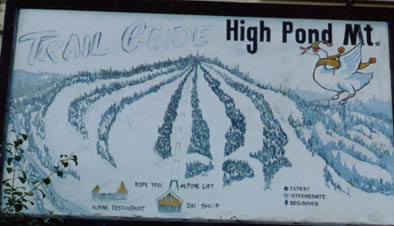 |
"Trail map that's on the front of the T-bar building. The building also contained the rental shop." |
| "The Alpine Restaurant" | 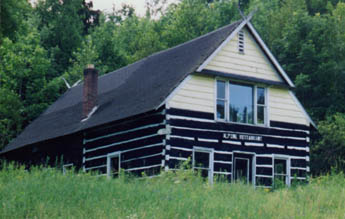 |
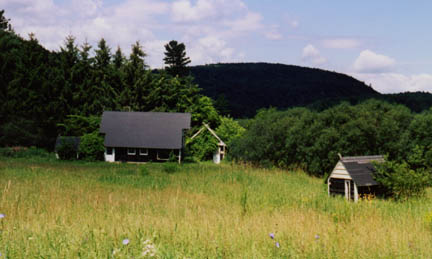 |
"The small building to the right is the small rope tow building. Building in the middle is the rental shop. Small one to the left is the T-bar base building. The one right next to the big one (rental shop) is the ski patrol." |
| "View from the road. You can see the T-bar lift as it rises into the woods. To the left of the T-bar is one of the rope tow poles (leaning to the left with the wheel on top). Note the hay bales. Someone has been haying the area." | 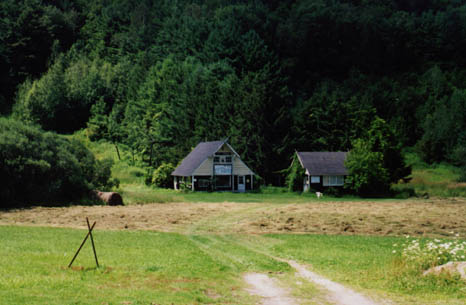 |
And Ryan Grace visited this area in 2007. He was able to hike to the top. Click on each image for the larger version
Base Area
Lift/Liftline
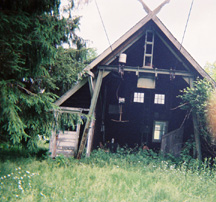 |
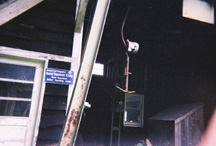 |
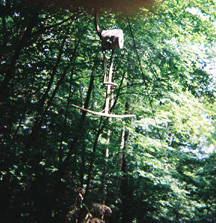 |
| Base of T-bar looks like it is in great shape! | A closeup of a T-bar and the Doppelmayr sign | Closeup of a T-bar on the liftline. |
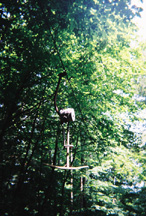 |
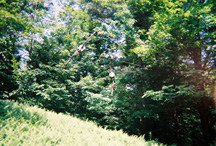 |
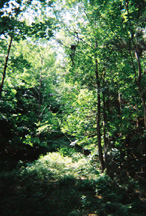 |
| Another T-bar on the line. | Looking at the liftline from an angle. | Looking up the liftline. |
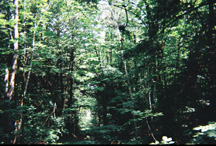 |
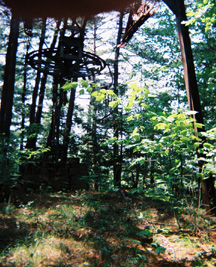 |
 |
| The liftline. | Summit of ski area, top of lift. | Control shack. |
Other
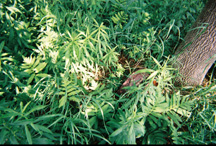 |
| Remnants of a rope tow on the ground. |
If you remember this area, please email us and tell us about it.
Last updated: August 27, 2007